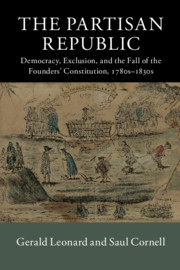Book contents
- The Partisan Republic
- New Histories of American Law
- The Partisan Republic
- Copyright page
- Dedication
- Contents
- Acknowledgments
- Introduction
- 1 The New Constitution
- 2 The Federalist Constitution and the Limits of Constitutional Dissent
- 3 The Democracy versus the Law: The Role of the Federal Judiciary, 1789–1815
- 4 The Paradoxes of Jeffersonian Constitutionalism
- 5 The White Democracy
- 6 The Marshall Court, the Indian Nations, and the Democratic Ascendancy
- Conclusion: The Constitutional Triumph and Failure of the Democratic Party
- Bibliographical Essay
- Index
1 - The New Constitution
Published online by Cambridge University Press: 28 January 2019
- The Partisan Republic
- New Histories of American Law
- The Partisan Republic
- Copyright page
- Dedication
- Contents
- Acknowledgments
- Introduction
- 1 The New Constitution
- 2 The Federalist Constitution and the Limits of Constitutional Dissent
- 3 The Democracy versus the Law: The Role of the Federal Judiciary, 1789–1815
- 4 The Paradoxes of Jeffersonian Constitutionalism
- 5 The White Democracy
- 6 The Marshall Court, the Indian Nations, and the Democratic Ascendancy
- Conclusion: The Constitutional Triumph and Failure of the Democratic Party
- Bibliographical Essay
- Index
Summary
- Type
- Chapter
- Information
- The Partisan RepublicDemocracy, Exclusion, and the Fall of the Founders' Constitution, 1780s–1830s, pp. 8 - 41Publisher: Cambridge University PressPrint publication year: 2019



